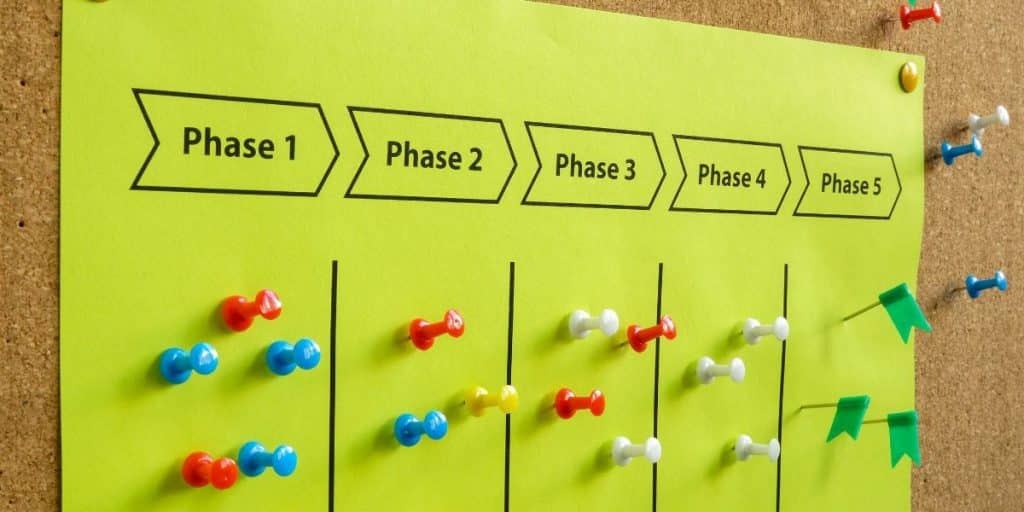Project management is a complex process that involves a lot of moving parts. Successfully navigating the five stages of project management is crucial to delivering the desired results. From initiation to closure, each stage presents its own set of challenges that can make or break your project. As a skilled assistant who specializes in copywriting, content writing, and all forms of digital marketing, I understand the importance of effective project management. In this article, I will share with you some essential tips on how to navigate the five stages of project management and deliver results. Whether you’re a seasoned project manager or just starting, this article will equip you with the knowledge and tools you need to succeed. So, let’s dive in and explore the five stages of project management and how to navigate them successfully.
The five stages of project management
Stage 1: Initiation
The initiation stage is the first stage of project management. It involves defining the project’s objectives, scope, and stakeholders. During this stage, you should identify the project’s purpose, understand the project’s goals and objectives, and determine the feasibility of the project. You should also identify the stakeholders and their requirements.
One of the main challenges during the initiation stage is the lack of clarity. It is essential to define the project’s objectives and scope clearly. Failure to do so can lead to scope creep and project delays. To overcome this challenge, it is crucial to involve all stakeholders in the project’s initiation stage. It will ensure that everyone is on the same page and understands the project’s purpose and goals.
Stage 2: Planning
The planning stage is where you develop a comprehensive project plan. During this stage, you should identify the project’s tasks, estimate the resources required, and develop a timeline for the project. You should also create a budget, allocate resources, and identify potential risks.
One of the main challenges during the planning stage is the lack of detail. It is essential to develop a detailed project plan to ensure that all tasks are accounted for, and the project is completed on time and within budget. To overcome this challenge, it is crucial to involve all stakeholders in the planning process. It will ensure that everyone understands their roles and responsibilities and the project’s timeline.
Stage 3: Execution
The execution stage is where you put the project plan into action. During this stage, you should communicate with the project team regularly, monitor progress, and make adjustments to the plan as necessary. You should also manage any issues that arise during the project and ensure that the project is progressing as planned.
One of the main challenges during the execution stage is managing the project team. It is essential to communicate regularly with the project team and provide them with the necessary resources and support to complete their tasks. To overcome this challenge, it is crucial to establish regular communication channels and provide the team with the necessary training and support.
Stage 4: Monitoring and Control
The monitoring and control stage is where you monitor the project’s progress and make any necessary adjustments. During this stage, you should track project milestones, monitor the budget, and manage any risks that arise. You should also ensure that the project is progressing as planned and make any necessary adjustments to the project plan.
One of the main challenges during the monitoring and control stage is identifying potential issues before they become problems. It is essential to monitor the project regularly and identify any issues that arise. To overcome this challenge, it is crucial to establish regular monitoring procedures and involve all stakeholders in the monitoring process.
Stage 5: Closure
The closure stage is where you finalize the project and hand it over to the stakeholders. During this stage, you should ensure that all project deliverables are completed, and the project is delivered on time and within budget. You should also conduct a project review to identify any lessons learned and make any necessary adjustments to the project plan for future projects.
One of the main challenges during the closure stage is ensuring that all project deliverables are completed. It is essential to ensure that all project deliverables are completed and that the stakeholders are satisfied with the project’s outcome. To overcome this challenge, it is crucial to establish clear project deliverables and involve all stakeholders in the project review.
Common challenges in project management
Project management can be challenging, and many factors can impact the success of a project. Some common challenges include:
Lack of clarity
One of the most significant challenges in project management is the lack of clarity. It is essential to define the project’s objectives and scope clearly.
Poor communication
Poor communication can lead to misunderstandings and delays in the project. It is essential to establish regular communication channels and involve all stakeholders in the project.
Scope creep
Scope creep occurs when the project’s scope expands beyond what was originally planned. It can lead to delays and increased costs. To avoid scope creep, it is essential to establish clear project deliverables and involve all stakeholders in the project.
Resource constraints
Resource constraints can impact the project’s timeline and budget. It is essential to allocate resources effectively and manage them efficiently.
Tips for successfully navigating the five stages
Navigating the five stages of project management successfully requires careful planning, effective communication, and efficient resource management. Here are some tips to help you navigate the five stages successfully:
Define clear project objectives and scope
Defining clear project objectives and scope is essential to the success of the project. It will ensure that everyone is on the same page and understands the project’s purpose and goals.
Establish regular communication channels
Establishing regular communication channels will ensure that everyone is up to date with the project’s progress and any issues that arise.
Develop a detailed project plan
Developing a detailed project plan will ensure that all tasks are accounted for and the project is completed on time and within budget.
Allocate resources effectively
Allocating resources effectively and managing them efficiently will ensure that the project is completed on time and within budget.
Monitor the project regularly
Monitoring the project regularly will ensure that any issues are identified early on and addressed before they become problems.
Tools and resources for project management
There are many tools and resources available to help you manage your projects effectively. Here are some of the most popular:
Project management software
Project management software can help you plan, track, and manage your projects effectively.
Gantt charts
Gantt charts can help you visualize the project timeline and identify any potential delays.
Risk management software
Risk management software can help you identify and manage potential risks.
Collaboration tools
Collaboration tools can help you communicate effectively with your project team and stakeholders.
Conclusion
In conclusion, navigating the five stages of project management successfully requires careful planning, effective communication, and efficient resource management. By defining clear project objectives and scope, establishing regular communication channels, developing a detailed project plan, allocating resources effectively, and monitoring the project regularly, you can deliver the desired results. Use the tools and resources available to you to help you manage your projects effectively. Remember to conduct a project review to identify any lessons learned and make any necessary adjustments to the project plan for future projects.
Related Articles:











